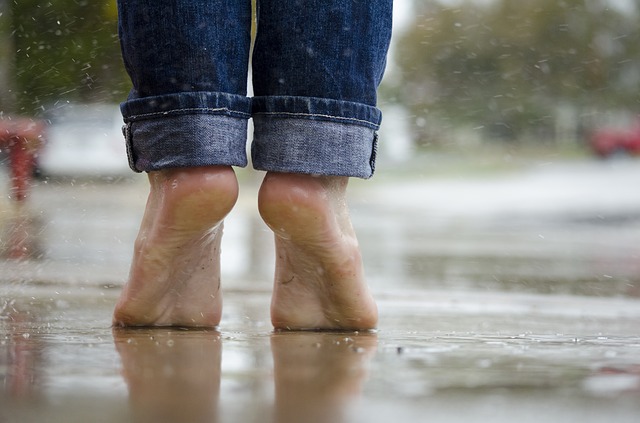Barefoot VS Footwear – in walking and running
Our feet consist of 26 bones, 33 joints and 19 muscles (Anatomy of the moving body, 2008). The arches of our feet, created by the structure of the bones and how they are connected by the intrinsic muscles and ligaments, give more support and flexibility to our feet and are also responsible for spreading forces across the feet during movement. In addition, our feet contain a large capacity of mechanical receptors that play a huge role in our sensory system, giving us balance and stability when in contact with the ground. The important role of our feet is highlighted by all these facts – but what’s less clear is how footwear may be affecting our feet, since the time we began habitually wearing them.
With increased use of footwear and its evolution from sandals to all the different types of shoes such as high heels, athletic shoes, pointy shoes and so on, there has been a realized increase of foot and toe deformities in the general Westernized populations such as hallux valgus (inward position of the big toe), bunions, flat feet and other painful leg syndromes with reduced ranges of ankle motion. Therefore, the importance of good footwear shouldn’t be overlooked.
As we know, function changes structure over time, therefore most footwear will influence foot structure and in turn influence foot functionality, that lead to the problems mentioned below. In a review that assessed various studies on the differences between being barefoot or wearing footwear during walking, many different variables were found. Research also showed how specific types of footwear can directly influence function, such as modern athletic footwear that have thick soles – wearing these create an imbalance of muscle activity (over-activity of peroneus longus muscle) in the lower leg that eventually interferes with ankle stability. It’s also no secret that footwear, like wearing a glove on your hand, affects the sensation (and kinesthesia) overall. This largely influences awareness of foot position and foot proprioception which are strong factors that correlate with ankle instability and the occurrence of ankle sprains.
From a large review of studies, it is apparent that barefoot walkers use wider foot placements, as their feet/toes are able to fan out more when walking. Also, shorter step lengths, faster paces and more importantly lower peak ground reaction forces at initial contact and lower plantar pressures, are other variables found, when comparing them to people walking with shoes. However, there are also differences between those who are habitually barefoot and those who are habitually shod wearers who start to walk barefoot (which at the beginning show higher peak pressures in their steps). This may be explained by the fact that habitually barefoot people have already adapted the “natural” foot gait, and also have normally wider feet than those who wear shoes. It’s important to note that in the older population (50+ years) there has been little to no research on the effects of walking barefoot.
Common issues that develop from use of footwear, specifically bad footwear are;
Plantar fasciitis – an acute inflammation of the sole of the foot, causing tightness and pain. Flat feet –from constant use of typical footwear our feet aren’t able to neither move the toes properly nor change its shape on different terrain as they are enclosed in the shoe and eventually this could cause our arches to fall and our foot muscles to get “lazy”. Bunions and narrowing of feet – painful bony lumps, usually on the side of the big toes, that are common from pressure of narrow or pointy shoes. Hallux valgus – big toe deformity to an inward position towards the second toe, commonly caused by bunions as well and the weakness of the toe muscles. Shortened Achilles tendon or tendonitis – huge issue that comes from wearing heels or shoes with higher heel pads. Research has reported that wearing high heels (of 5cm or over) have significant effects to the muscles of the calf and the Achilles tendon (heel cord), resulting in a forward position of the ankles at rest and a decreased range of motion, along with pain and muscle tightness.
Based on research alone, it’s not possible to recommend specific types of footwear for everyone but according to the facts and what is known already about the effects of footwear on sensation, stability, balance and foot shape in general, it’s safe to say that walking barefoot has higher benefits to the maintenance or improvement of foot functionality. You don’t have to walk around barefoot all the time, where these days it is not even a possibility for all however what’s important is choosing what you are wearing for the majority of the day correctly. ‘Flexible’ shoes are highly recommended, also minimalistic or barefoot type shoes are not uncommon in the market these days which are specifically designed to mimic barefoot walking. I cannot advertize a certain type of shoe or compare the different brands, however, certainly the more free your foot is, the better. If your shoes are narrow, pointy and tough, they will not do your feet any good. Getting more barefoot time regularly is another preventive option for those not willing to invest in new items. Spending time walking around barefoot at home, in the park, your garden or even in your office, is a good way to give your feet some freedom. A certain fact is the importance of being barefoot for a growing child – during development it is most important to allow your child’s feet to move in their most natural state, especially in the first few years of life, where many factors including wearing shoes can hinder the development of the arches, bones of the feet and their structure and the function of the muscles that develop accordingly.

